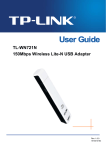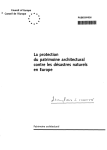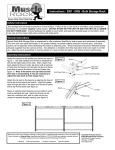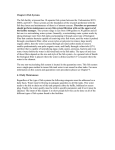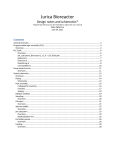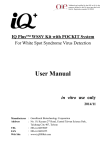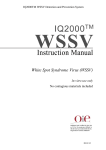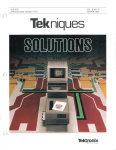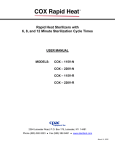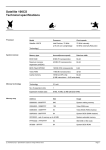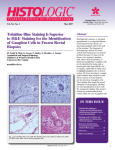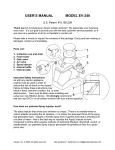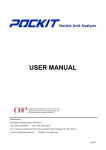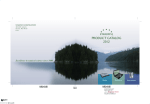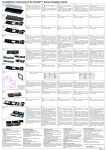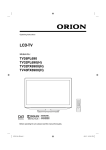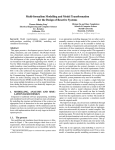Download View
Transcript
Fisheries and Aquaculture Journal Zadlock et al., Fish Aquac J 2014, 5:2 http://dx.doi.org/10.4172/ 2150-3508.100095 Research Article Open Access A Low Cost, Stand-Alone, Cold Water Aquatic Animal Research Housing System Frank J Zadlock IV1, Jianjun Feng1, Henri Estanbouli1, Maria Bender1 and Ziping Zhang2* 1Department of Biological Sciences, Seton Hall University, 400 South Orange Ave, South Orange, NJ 07079, USA 2Department of Natural Sciences and Mathematics, SUNY Cobleskill, Cobleskill, NY 12043, USA *Corresponding author: Ziping Zhang, Department of Natural Sciences and Mathematics, SUNY Cobleskill, Cobleskill, NY 12043, USA, Tel: 518-255-5466; E-mail: [email protected] Received date: April 14, 2014; Accepted date: June 17, 2014; Published date: June 25, 2014 Copyright: © 2014 Zhang Z, et al. This is an open-access article distributed under the terms of the Creative Commons Attribution License, which permits unrestricted use, distribution, and reproduction in any medium, provided the original author and source are credited. Abstract Currently, there are a few low-cost set-up aquatic research animal housing system constructions out in publication and they are only suitable for warm water animals but not for cold water animals. We have constructed the first novel cold water stand-alone aquatic animal research housing system that can be used to rear small fish species and embryos with temperature requirements ranging from below room temperature to -5°C. The advantages of this system are that it is less expensive option compared to commercial vendors and is easy to assembly. Our twenty four tank cold water system can simply be modified to accommodate warm water animal research as well, making this system extremely versatile as compared to others of its kind. Keywords: Low cost; Stand-Alone; Cold water aquatic animal research housing system Introduction Aquatic animals are gaining a lot of attention for being fantastic model organisms not only for their favorable research characteristics but also because of their amicable housing requirements compared to other model organisms. Aquatic housing systems in general do not require a daily cleaning, are cheaply maintained, and can host hundreds of aquatic animals in a very small space. There are two types of system structures which can be created with regards as how the water flows; stand-alone and flow-through. A flow-through system is one which constantly receives new water from an outside source into its system and releases the excess water within the system through a drain. While a stand-alone system is one which reuses the water it holds and filters the old water to make it usable once again. The benefits of a stand-alone system compared to a flow-through system is that it’s closed system improves the bio-security of the recirculating water with multiple purification processes, reduces routine maintenance, and is self-sustainable in the regards that it will be able to maintain its function without outside interference. While a flowthrough system continuously introduces new water into the aquatic housing system, demanding high water costs and diligent water quality monitoring. Most aquatic housing system constructions out in publication are for warm water animal research, but for a more tailored system, commercial vendors are able to supple all the bells and whistles Part Part Number Rack Edsal 48 in. W x 84 in. H x 18 in. UR184884L6 D Steel Commercial Shelving Unit Fish Aquac J ISSN:2150-3508 FAJ, an open access journal (Aquaneering; Pentair Aquatic Eco-Systems, Aquatic Enterprises, Inc.) [1,2]. The cost of such systems and the dependency to purchase maintenance parts made specifically for that system from the vendor could be expensive for smaller institutes and start-up laboratories (Figure S3). We have constructed cold water, stand-alone, aquatic animal research housing system that can be used to maintain cold water animals and can be modified to become suitable for warm water animal research as well. It should be noted that “warm water” refers to room temperature and “cold water” refers to a temperature range lower than room temperature to -5ºC. This multi-functional system is an alternative less expensive option that is easy to assemble and maintain for smaller research groups. Our lab has successfully been able to mimic the cold water temperature requirements for the development of sea lamprey embryos and experienced no microbial contamination for the entire two month duration of the experiment (Figure S1). Currently, no such system construction for the embryonic research exists in publication while the interest in the research area is prevalent. This system would be suitable for not only lamprey embryonic research but also trout [3], salmon [4], tuna [5], walleye [6], northern pike [7], freshwater shrimp [8], oyster [9], and other cold water organisms. Materials The parts and tools required for the assembly of the self-sustainable cold water recirculating aquatic animal research housing system can easily be purchased (Tables 1 and 2). Vender Quantity Total Lowes 1 $75.00 Volume 5 • Issue 2 • 100095 Citation: Zadlock FJ, Feng J, Estanbouli H, Bender M, Zhang Z (2014) A Low Cost, Stand-Alone, Cold Water Aquatic Animal Research Housing System. Fish Aquac J 5: 095. doi:10.4172/ 2150-3508.100095 Page 2 of 6 ½” I.D., Vinyl reinforced clear tubing, TVR70 50’ coil Aquatic Eco-Systems 2 $58.80 ¾” I.D., Vinyl reinforced clear tubing, TVR90 50’ coil Aquatic Eco-Systems 1 $33.03 3/16” I.D., Vinyl clear tubing, 100’ coil TP30HD Aquatic Eco-Systems 1 $20.65 1/4” I.D. Vinyl clear tubing, 50’ coil TV40F Aquatic Eco-Systems 1 $33.03 Tank fitting kits (bulkhead kit), ½” TFK1 Aquatic Eco-Systems 24 $165.60 Screw clamp SC212 Aquatic Eco-Systems 30 $186.30 Miniature stopcock, 5/16” MSK558 Aquatic Eco-Systems 24 $47.04 Air diffusers, 1.5" L x .5" W, 3/16" O.D. AS1 barb (4 mm), ABS Aquatic Eco-Systems 24 $40.80 PVC pipe, ½” pipe size 5’ N/A Local Hard Ware Store 1 $13.40 Female adapter (1/2” slip x 1/2” FNPT) 435005 Aquatic Eco-Systems 24 $6.48 Clear rectangular tank 18”x 12”x 3 ½” 3307 2.5 gallon Rubbermaid 24 $628.80 Lids for 2 gallon tank 3310 Rubbermaid 24 $254.40 Top Fin® Air Pump AIR-8000 3742976 Pet Smart 2 $60.00 Reducing tee (1/2" Barb x 1/2" Barb x 122A 1/2" FNPT) Aquatic Eco-Systems 24 $49.20 Tubing adapters tees, 3/16" barb 62063 Aquatic Eco-Systems 24 $16.58 Male adapters, 1/2" NPT 3/16" barb 62013 Aquatic Eco-Systems 24 $15.60 Aquarium Net NET275 Aquatic Eco-Systems 24 $60.00 Tee, 1/2" NPT x 1/2" x 1/2" 62123 Aquatic Eco-Systems 26 $27.82 By-pass filter housing FXB Aquatic Eco-Systems 2 $90.62 Particulate cartridge FX5 Aquatic Eco-Systems 1 $6.75 Tubing valve, clamp type, 1/8” to 3/8” DC10 Aquatic Eco-Systems 12 $10.08 UV Sterilizer Classic 80 Watt Aqua Ultraviolet 1 $590.80 1/3 hp Chiller CY-4 Aqua Logic Inc. 1 $967.69 Digital Temperature Controller TR115SN Aqua Logic Inc. 1 $135.59 Lowes 1 $35.00 ESHOPPS 1 $178.99 2 $3.62 smartpond 130-170 Pump w/auto shutoff GPH Fountain FP170AS Wet Dry Filter Complete System 75-100 WD-100CS gallons Watts 1/2 in. x 1/2 in. x 1/2 in. Plastic A-381 Barb Tee Cable tie (14”) N/A Local Hardware Store 1 pack $13.47 Mesh Cloth N/A Local Hardware Store 1 $19.77 Rubber bands N/A Local Hardware Store 1 pack $2.92 3” stainless steel screw clamp N/A Local Hardware Store 1 $1.95 Potassium permanganate 500 grams MKBK7079V Sigma-Aldrich 1 $74.99 Fish Aquac J ISSN:2150-3508 FAJ, an open access journal Volume 5 • Issue 2 • 100095 Citation: Zadlock FJ, Feng J, Estanbouli H, Bender M, Zhang Z (2014) A Low Cost, Stand-Alone, Cold Water Aquatic Animal Research Housing System. Fish Aquac J 5: 095. doi:10.4172/ 2150-3508.100095 Page 3 of 6 Total $3,924.77 Table 1: Parts Required For The Construction Of The Aquatic Animal Research Housing System. Tool Quantity Screw gun 1 Mitter Bow with backsaw 1 2” Tube cutter 1 Ruler 1 1-1/8” Hole Saw (Milwaukee® Ice Hardened) with ¼” drill bit 1 PVC glue 1 Table 2: Tools Required For The Construction Of The Aquatic Animal Research Housing System. Construction Room Requirements: The aquatic housing system should be placed in a room with proper air flow and ventilation to help maintain the cold water requirements. The room should have a sink nearby to supply water to the system and for routine maintenance purposes. The system should be placed near GFI outlets that are preferably run on a back-up generator keeping in mind that the front and back of the system should be easily accessible. For the aquatic animals of choice, the room should be equipped with an automatic light switch timer and the light periods and dark periods would vary depending on the organism. For the development of the sea lamprey embryos, the recommended photo period of 10 hours dark and 14 hours light were employed. floor to allow enough space for the chiller (CY-4) and wet dry filter complete system (WD-100CS). Shelves one through six will each have four aquatic tanks (3307) for a total of twenty four. The top shelf will be utilized for the air pumps (3742976) and UV sterilizer (Classic 80 Watt) (Figure 1). Tank Assembly In the front of the 2.5 gallon tank, a hole should be drilled 2.5” from the bottom on center for the head (TFK1) using a 1-1/8” hole saw (Milwaukee® Ice Hardened) with ¼” drill bit (Figure 1). The ¼” drill bit will drill the primary hole and hold the 1-1/8” hole saw in place to drill the larger hole. Once the hole is drilled, apply cement around the bulkhead and insert the bulkhead into the tank. Using a rubber band, attach a piece of mesh cloth around the interior piece of the bulkhead. This will allow water to still pass while preventing small developing organisms from being removed through the drainage system such as the developing sea lamprey embryos. Using the mitter box and handsaw, cut 3” of the ½” PVC pipe. Apply PVC glue and insert this into the bulk head. Apply PVC glue to the female adapter (435005) and insert it into the PVC pipe then screw in the male adapter (62123). To provide water and aeration to the tank, drill two holes at opposite sides on one end of the lid using a ¼” drill bit (Figure 1). Rack with Tank Assembly The system should be placed in a location that takes into consideration the requirements stated previously for the room. The system will have seven shelves that are 10 inches apart. The spacing between the shelves is important to allow easy accessibility to open the lids on the tanks. The firstshelve should be placed two feet from the Fish Aquac J ISSN:2150-3508 FAJ, an open access journal Figure 1: Tank Side View and Front View of assembled water system. Details of the part numbers are included in Table 1. Volume 5 • Issue 2 • 100095 Citation: Zadlock FJ, Feng J, Estanbouli H, Bender M, Zhang Z (2014) A Low Cost, Stand-Alone, Cold Water Aquatic Animal Research Housing System. Fish Aquac J 5: 095. doi:10.4172/ 2150-3508.100095 Page 4 of 6 Once all twenty four tanks are placed on the assembled rack, the drainage system can be constructed (Figure 2). For the first tank on the left side of each row, cut a 10” piece of ½” I.D., vinyl reinforced clear tubing (TVR70) and insert it into the tubing adapter tee (62123) in such a way that it curls up the side of the rack’s column (Figure 1). This will allow oxygen into the drainage system to help with the water flow. It may help to soak the vinyl tubing in hot water before sliding them over the barbs of the tubing adapter tees (62123). For the interior tanks on each shelf cut 11 inches of ½” I.D., vinyl reinforced clear tubing (TVR70) to connect to the other tanks tubing adapter tees (62123). Each shelf has its own drainage line; however, the drainage lines for shelves 1 and 2 are coupled together as well as 3 and 4. These two pairs are connected using a ½” x ½” x ½” plastic barb tee (A-381). This was done to increase flow of water into the wet dry filter complete system (WD-100CS). Figure 2: Front view of assembled water system (photo). Some existing low cost housing systems use PVC piping instead of the slightly more expensive vinyl tubing [2]. The reason for our use of the vinyl tubing is ultimately for its transparent characteristics which will be used in order to observe the water flow to monitor the efficiency of the pump, detect any microbial contamination within the lines, monitor debris in the lines that may accumulate, and to give the confidence that the system is clean enough to transition from shutdowns to housing experimental animals. The clear vinyl tubing also gives the ability of easily identifying sections that need to be removed from the system for cleaning with a tubing brush or sections that need to be excised out for replacement. Much research suggests that microbial debris within housing systems have an adverse effect on the animals growing within it such as affecting the growth rate and increasing mortality rates [10]. The added cost of the clear vinyl tubing will save in the long run by providing an extra insurance in maintaining an efficient system with high quality water during experimental housing times. The water inlet system and air supply will be assembled on the opposite side of the drainage system in a continuous “S” like pattern and will be held in place with cable ties (Figure 3). For the water inlet system, screw 24 individual male adapters (62013) into 24 individual reducing tees (122A). The first tank on the left on the first self will receive water from the UV Sterilizer. This connection will be done after the UV sterilizer is installed. Cut eighteen 9.5” pieces of the ½” I.D. vinyl reinforced clear tubing (TVR70) using the tube cutter. Fish Aquac J ISSN:2150-3508 FAJ, an open access journal Connect the male adapter/reducing tee combos with the vinyl tubing in the following pattern for six sets (tee-tube-tee-tube-tee-tube-tee). Hang the tubing with the attached male adapter/reducing tee combos on the shelf that is above the tanks with cable ties for shelves one through six. Cut five 16” pieces of ½” I.D., vinyl reinforced clear tubing (TVR70) to connect the shelves continuously is an “S” like pattern (Figure S2). The first tank on the left of the bottom shelf will have a piece of vinyl tubing (TVR70) that will run to the charcoal/bio ball compartment of the wet dry filter complete system (WD-100CS). In addition, the drainage for the last shelf will also include reinforced vinyl tubing (TVR70) that will carry the pumped water from the UV sterilizer into the wet/dry complete system (WD-100CS). Figure 3: Back view of assembled water system. This shows the “S” form that allows water to go from the UV sterilizer to the individual tanks (photo). To supply water to each tank individually, cut twenty four 5” pieces of 3/16” I.D., vinyl clear tubing (TP30HD) and connect each one to each tank’s male adapter (62013). Connect the smaller end of the tubing valve (SC212) into the other end of the 3/16” I.D. vinyl clear tubing. Cut twenty four 5” pieces of 1/4” I.D. Vinyl clear tubing (TV40F) and attach each one individually into the larger end of the tubing valve (SC212). Then insert the other end into the left hole of the lid into the tank. For the air supply system, the first tank on the right of each shelf will receive the air from one of the sources of the silent air pump (3742976) which will be placed on the right side of the top shelf (Figure 1). Cut eighteen 11” pieces and six 3” pieces of 3/16” I.D., vinyl clear tubing (TP30HD) using the tube cutter. Connect the tubing adaptors tees (62063) with the vinyl clear tubing in the following pattern for six sets (tee-11”tube-tee-11”tube-tee-11”tube-tee-3”tube pinched off). Pinch off the last tube for each set with a screw clamp (DC10) to help maintain the air pressure throughout the system. Hang the tubing with the attached tubing adaptor tees on the shelf that is above the tanks with cable ties for shelves one through six. Cut six pieces of varying size of 3/16” I.D., vinyl clear tubing (TP30HD) to connect the silent air pump (3742976) to each shelf individually (Figure 1). To supply air into the tanks, cut twenty four 9” pieces of Volume 5 • Issue 2 • 100095 Citation: Zadlock FJ, Feng J, Estanbouli H, Bender M, Zhang Z (2014) A Low Cost, Stand-Alone, Cold Water Aquatic Animal Research Housing System. Fish Aquac J 5: 095. doi:10.4172/ 2150-3508.100095 Page 5 of 6 3/16” I.D. vinyl clear tubing (TP30HD). Connect the tubing to the barb of each inlet adaptor tee (62063) for each tank and insert the other side through the right side hole of the lid into the tank. Attach the air diffuser (AS1) to the end in the tank (Figure 1). Cold Water Recirculating System Assembly Assemble the wet dry filter complete system (WD-100CS) per the manufacturer’s recommendations. This system will provide two components of the water purification system, charcoal bags and bio balls. The charcoal is one of four components of the water purification system. It will remove certain impurities such as chlorine while ignoring others like nitrates, which will be addressed by other components of the water purification system. The bio balls within this system will provide the surface for the growth of denitrifying bacteria to remove nitrates from the water. Place this system on the right side of the rack, underneath the bottom shelf (Figures 2 and 4). Make sure that the drainage tubes are placed into the charcoal/bio ball compartment of the wet dry filter complete system (WD-100CS). Figure 4: The drainage tubes are carrying contaminated water from the tanks into the wet dry filter complete system. The main mechanisms are the particulate filter, wet dry filter complete system, and chiller. The UV sterilizer (Classic 80 Watt) should be assembled per the manufacturer’s recommendations and the PVC parts should be attached together with PVC glue. The sterilizer is another component of the water purification system and is used for the management of various water- born microorganisms. The flow rate of the pump (1800 gallons per hour) is within the specifications for the UV sterilizer (2,200-4,400 gallons per hour) to work properly. Place the sterilizer on the left side of the top shelf, opposite from the air pump (Figure 1). The downstream location of the sterilizer from the filter system (charcoal bags, bio balls, and particulate filter) meets the manufacturer’s suggestion to avoid particulates from ruining the light bulbs. Cut a piece of ½” I.D., vinyl reinforced clear tubing (TVR70) to connect the outlet of the UV sterilizer to the male adapter/reducing tee combo of the first tank of the system located on the sixth shelf on the left side. The pump (FP170AS) should be placed in a box with water that is separate from the recirculating system. This is to reduce the amount of heat introduced into the system and is why a sump pump is not used as seen in other low cost standalone systems [1]. Cut a piece of ¾” I.D., vinyl reinforced clear tubing (TVR90) to connect the outlet of the pump to the inlet of the UV sterilizer. Cut a 16”piece of 3/4” I.D., vinyl reinforced clear tubing (TVR90) to connect the particulate filter housing (FXB) to the right of the pump (FP170AS). The particulate Fish Aquac J ISSN:2150-3508 FAJ, an open access journal filter housing is the 4th component of the water purification system. The particulate filter housing will be connected into the water reservoir of the wet dry filter complete system (WD-100CS). Cut a 25” piece of 3/4” I.D., vinyl reinforced clear tubing (TVR90) to connect the particulate filter to the bottom of the water reservoir (WD-100CS) (Figure 4). In the event of a leakage, the best way to control the situation without damaging the pump and other devices is to shut off all power to the pump and all other equipment. The chiller (CY-4) will be positioned on the bottom shelf and its coil will be placed in the water reservoir of the wet dry filter complete system (WD-100CS) (Figure 4). The chiller can be adjusted to meet the desired water temperature depending of the model organism’s idea cold water temperature. For the development of sea lamprey embryos, our system maintained a temperature of 16°C and the outside temperature should be at the range of 18-21ºC maximum. Install the digital temperature controller (TR115SN) with cable ties to the front left post of the rack system. The thermometer will be able to be placed in various tanks to make sure that the temperature is maintained throughout the system. In the event that research on warm water organisms is desired, the chiller can be removed or replaced with a heater. According to the product description, this particular chiller is able to reach temperature range of 17°C to 1°C with a ± 1°C difference, ultimately increasing our control over acquiring specific temperatures for optimum housing environments. These precise temperature ranges are essential for the growth of many particular cold water fish. For example, experiments performed on Atlantic salmon have determined the highest embryonic growing rate is achieved at 14°C, while the growth at temperatures a few degrees higher and lower are shown to differ in their growth rates [11]. In the case of the lamprey, during the duration of our two month growing season, a successful 16°C was maintained to mimic its natural aquatic habitats. Complete System Considerations Since this is a closed recirculating system, the chlorine in the water could be removed before it is introduced into the system. This could be achieved by filling a clean garbage can up with water and installing an air diffuser (AS1) connected to a piece of 3/16” I.D. vinyl clear tubing (TP30HD) that is connected to an air pump to the bottom of the garbage can. The air pump should run for at least 24 hours to successfully remove the chlorine. Once the system is complete, it should be run to check for leaks and the water should be changed out a few times along with the filter before animals are going to be introduced to the system. This will make sure that any leaching from the PVC glue will be removed from the system and not affect the health of the animals. If any leaks do occur, make sure that the seal between the pipes and the system are properly attached using PVC cement. The particulate filter should be changed every three months per the manufacturer’s recommendation once the system is up and running normally. A shutdown procedure should be created for the system. The system should be run with potassium permanganate (1 g/100000ml-1 g/5000 ml) for two days to sterilize the system followed by removing the filter and all the water from the tanks and hoses. Then fresh water and a new filter should be installed back into the system for one day to remove any residual potassium permanganate. Then the water should be removed, along with the filter and the system would be considered clean. Volume 5 • Issue 2 • 100095 Citation: Zadlock FJ, Feng J, Estanbouli H, Bender M, Zhang Z (2014) A Low Cost, Stand-Alone, Cold Water Aquatic Animal Research Housing System. Fish Aquac J 5: 095. doi:10.4172/ 2150-3508.100095 Page 6 of 6 Discussion Hohn and Hanson [2] had created a low cost flow-through aquatic research animal housing system that is similar to our low cost standalone system. Although they seem comparable, the two systems are functionally different. The first restriction of their flow-through system is that it requires a floor drain, limiting the number of potential laboratories capable of utilizing their low-cost aquatic housing system. Since most facilities are not equipped with a floor drain, installing one would defeat the purpose in building their low-cost aquatic housing system. The reason why this system requires a drain is due to the continuously flow of water that passes through it circumventing the need of purification processes such as UV sterilizers, bio-balls, and carbon filters. With this said, their water delivery process runs the risk that the water is contaminated before it enters the tanks, potentially jeopardizing the experiment. Running this continuous water delivery process increases the original estimated price of this facility. As far as overall construction price is concerned, the Hohn and Hanson [2] paper spoke about how low-cost their system totaled out to be. This might have been true back in 2007 when the paper was created, however due to inflation seven years later, this is no longer true. After recalculation, the price of the entire system totaled to be more than the suggested $1200. Their paper also suggested the need for individual heaters within each of the fish tanks. However, these tank heaters were not added to the total price calculation nor did the authors give a way of determining the temperature of the water within the tanks. These reasons all suggest how this system is not as simple and practicable as it was suggested to be. Kim et al. [1] is a paper which described the building of a similar stand-alone low-cost aquatic system to ours but raised a few questions. Firstly, they circumvented the requirement for heaters by maintaining a room temperature set at 82°F year round. This would be a more expensive approach and not a viable option to laboratories in cold area climates. These laboratories would require a heating system to be installed to maintain constant tank temperature, which would increase the overall cost of this system. This article never took into account temperature monitoring within the system, which flagged a problem. Another issue within this particular article was that the authors purposely had not placed the UV sterilizer in the location as suggested by the user’s manual. The authors positioned the sterilizer before the filter instead of the suggested after. This location is not recommended due to the fact that if large debris were to get out of the tank and damages the sterilizer, the warrantee will not cover its replacement. The suggested $500 total price for their system is less than both our total cost as well as that suggested by Hohn and Hanson [2], even though all three systems were built with similar parts. This could have been true in 2009, however the prices were recalculated and the calculation of the essential rack, UV filter, pump, and kritter katcheres alone totaled $500 without any extra parts. Kim et al. [1] stated that their system can be built in half a day but from our experience, this seems to be a little ambitious considering that it took us about a day and a half to construct our smaller system. When comparing our stand-alone system to commercially built stand-alone systems, the main difference between them is seen in the cost. For our comparison, we attained quotes from three different Fish Aquac J ISSN:2150-3508 FAJ, an open access journal commercial vendors (Figure S3). All of the systems quoted are very similar to the system which we had created, containing 24: 2.5 gallons tanks, a standard filter system, UV sterilizer, a chiller appropriate for the system's size, and a temperature controlled monitoring system. These prices could be inhibitory for smaller institutes and start-up laboratories, making our system a logical alternative. Conclusion There are few low-cost aquatic systems out in publication with this being the first novel cold water aquatic animal research housing system for smaller fish and embryos. Our cold water, stand- alone aquatic animal research housing system can not only be used for cold water animals but with simple modifications, it can be converted to house warm water animals as well. As previously shown, this versatile system is a less expensive option compared to commercial vendors that is easy to construct and up keep for start-up labs and smaller research groups (Figure S3). In comparison to other low-cost systems in publication, our cold water system is better designed since it is assembled in such a way that it falls into compliance with all manufactures recommended installations and has no limitations on where it can be utilized because it does not require a floor drain. After successfully performing a two month lamprey embryo experiment with this novel aquatic animal research housing system, it became apparent that the setup of this system provided an optimum growing environment for coldwater fish research for a fraction of the price of commercial aquatic housing systems. References 1. 2. 3. 4. 5. 6. 7. 8. 9. 10. 11. Kim S, Carlson R, Zafreen L, Rajpurohit SK, Jagadeeswaran P (2009) Modular Easy-to- Assemble Low-Cost Zebrafish Facility. Zebrafish 6: 269-274. Hohn C, Petrie-Hanson L (2007) Low-cost aquatic lab animal holding system. Zebrafish 4: 117-122. Shelton J (1994) Trout Production. USDA Aquaculture Technical Series. Rungruangsak-Torrissen K, Carter CG, Sundby A, Berg A, Houlihan DF (1999) Maintenance ration, protein synthesis capacity plasma insulin and growth of Atlantic salmon (Salmo salar L.) with genetically different trypsin isozymes. Fish Physiology and Biochemistry 21: 223-233. Gibbs E (2013)Tuna Facts Sheet. Rhode Island Sea Grant. Colby PJ, McNicol RE, Ryder RA (1979) Synopsis of biological data on the walleye Stizostedion v. vitreum. Food Agriculture Organization of the United Nations. Raat AJP (1988) Synopsis of Biological Data on the Northern Pike. Esox lucius Linnaeus 1758. Borisov R, Kryakhova N (2011) Influence of lecithotrofic feeding on growth and development of larvae of freshwater prawn Macrobrachium rosenbergii. Russian Journal of Developmental Biology. 42: 148-152. Matthiessen G (2001) Oyster Culture. Fishing News Books Series. Skjermo J, Vadstein O (1999) Techniques for microbial control in the intensive rearing of marine larvae. Aquaculture 177: 333-343. Handeland SO, Imsland A, Stefansson S (2008) The effect of temperature and fish size on growth, feed intake, food conversion efficiency and stomach evacuation rate of Atlantic salmon post-smolts. Aquaculture 283: 36-42. Volume 5 • Issue 2 • 100095






